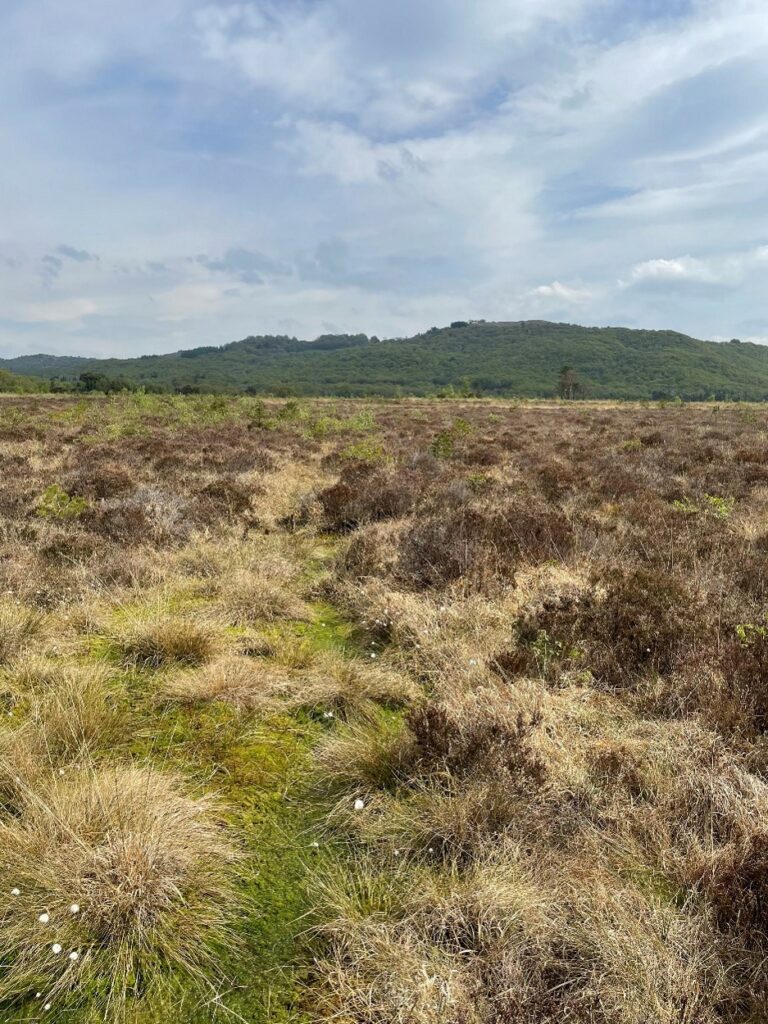Lead Supervisor: Nicholas Branch, Department of Geography and Environmental Science, University of Reading
Email: n.p.branch@reading.ac.uk
Co-supervisors: Steve Robinson, Department of Geography and Environmental Science, University of Reading; Barbara Silva, Natural England

Figure 1: Roudsea Woods and Mosses NNR (Cumbria); an LTMN peatland site.
The Natural England Long Term Monitoring Network (LTMN) aims to track environmental change, and understand the causes of change, across a range of habitats. LTMN data is used by Defra for National Emission Ceilings Regulations reporting, and aims to produce evidence beneficial to a breadth of Natural England work, Defra policy, and the wider conservation community. To this end comprehensive ongoing data collection on a suite of 37 nature reserves across England has been carried out since 2009, including vegetation, soil chemistry, mesofauna and microbes, butterflies, and air quality. A major challenge identified by the project, however, is a poor understanding of the historical context and likely future development of the environment at each reserve, in particular the response of peatland habitats to future climatic change. Key questions are (1) over what timescales were current environmental conditions emplaced, and is there evidence for a significant change in biodiversity?; (2) do the peatlands (bog and fen) that are a common habitat represent healthy ecosystems or indicate a trend towards biogeochemical degradation?; (3) are predicted future changes in precipitation and temperature as a consequence of global warming likely to initiate significant changes in peatland hydrology and biogeochemistry, and biodiversity, and what mitigation options might be explored to manage the problem? These are critically important questions because peatlands and the landscapes in which they are situated are important for a range of ecosystem services including carbon sequestration, water holding capacity, biodiversity, and the health and wellbeing of people who visit the reserves. The peatlands are also important archives of environmental and climate change, and human interaction with the natural environment, and their loss would represent a significant reduction in our ability to understand Earth’s history (our geoheritage).
The project will employ a mixed method approach at 2-3 key LTMN sites. Critically each site will have a peatland that has a record of the current biodiversity. Our objective is to expand the conclusions from research at these sites to increase understanding of the effects of future climate change scenarios on England’s peatland habitats more widely. To ascertain the historical development of the peatland and wider landscape, we will undertake a multi-proxy reconstruction of changing biodiversity utilising sub-fossil pollen grains and spores, sedimentary plant and animal DNA, and radiocarbon and Pb210 dating, extracted from sediment core samples. We will also investigate the relationship between changing biodiversity and (a) pollution by undertaking µXRF ITRAX geochemistry and analysis of carbonaceous particulate matter, and (b) climate variability by comparing published palaeoclimate and meteorological records with the new data. To ascertain whether the selected peatlands represent healthy ecosystems, we will undertake a reconstruction of changing hydrological and biogeochemical conditions utilising measurements of testate amoebae, ash content, moisture and bulk density, C and N ratios, and multi-element chemistry by ICP-MS extracted from sediment core samples, and compared to present day surface data (vegetation, pH, Eh, DO). To consider the likely effects of future climate change scenarios, we will evaluate the above findings within the context of LTMN datasets to increase understanding around the likely effects of climate change and explore potential beneficial mitigation options for each key site. The project will also involve a work placement within Natural England. This would be developed in collaboration with the LTMN and Geodiversity specialists and would likely encompass geoconservation experience in managing geological SSSIs, working with Landscape and Nature Recovery colleagues, opportunities to network within Natural England, and present and publish findings.
Training Opportunities
You will receive methods training specific to the study of peatland ecosystems. This will involve fieldwork at a number of LTMN sites, microscopy, the analysis of sub-fossil biological remains and sedimentary DNA, biogeochemical analyses and the application of a range of dating methods. The project will also involve a work placement within Natural England where you will work in collaboration with the LTMN and Geodiversity specialists with opportunities to network within Natural England.
Student Profile
This project would be suitable for students with a degree in Geography or Environmental Science, or a closely related environmental or physical science degree. Experience of fieldwork in peatlands, palaeoecological methods, especially the analysis of sub-fossil biological remains, or the application of biogeochemical techniques, would be desirable.
Funding Particulars
This project has CASE support from Natural England

